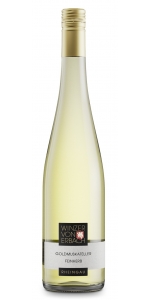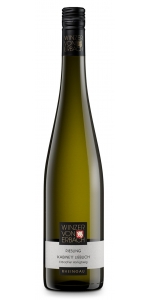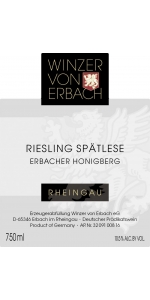Wine from Rheingau

Rheingau is a wine region in Germany that is named after the traditional region and translates to, “Rhine District.” Located in the state of Hessee, Rheingau is part of the Theingau-Taunus-Kreis administrative district. Although the region only makes up 3% of the German vineyard area, it historically significant, and includes many producer that have an international reputation. There were 7,720 acres of vineyards in 2008 with 78.8% being Riesling. Pinot Noir and Muller-Thurgau make up the rest. The region is best known for its small viticulture sites, perfect microclimate, and amazing landscape. Reheingau has a cool-continental climate with an annual temperature of 50° and only 21” of rainfall per year. Located on the River Rhine next to the villages of Lorch, and Assmannshause, Rheingau is almost 50 kilometers long, and rises to the Taunus Mountain Range. Most of the vineyards are located on the slopes facing south between the mountains and river, which makes for excellent wine-growing conditions. As early as the 12th century, grapes were planted in Rheingau. There was more red than white wine produced during this time and it was usually Gemischter Satz. During Medieval times there was more red wine produced and was usually Gemischter Satz. The Rheingau region is known for late harvest wine.
Winzer Von Erbach Goldmuskateller Rheingau Feinherb is 100% Goldmuskateller.
The old name for the Erbacher Honigberg was Wachholderwiesen-juniper meadows.
At the Wachholderwiesen there was an uprising of the peasants in the 16th century, all of the ringleaders were hanged.
The muskateller has a smell of elder-berries, apricots and quince, aftertaste of nutmeg.
Winzer von Erbach Riesling Eiswein is made from 100 percent Riesling.
The Eiswein has aromas of concentrated yellow fruit and a fruity sweetness. It's a high end product with a very long aging potential.
The grapes were picked frozen which resulted in a concentration of sugar, acidity and aromas and a low yield.
Pairs with blue cheese, fois gras, French apple cake.
Winzer Von Erbach Riesling Rheingau Erbacher Honigberg Kabinett is 100% Riesling.
This Riesling Kabinett shows hints of apple, citrus and peach and is mineral - scented.
The purity of fruit aroma combined with a unique and delicate fruit acidity makes this Riesling to a typical ambassador of one of the greatest grape varieties in the world.
Pairs well with gorgonzola, blue cheeses and pastas in a creamy sauce.
Honeyed style, rich minerality and luscious creaminess. Flavors of baked pineapple and pear. Fresh and juicy on the finish.
From the famous Erbacher Honigberg vineyard. Average of the vines is 20 years old.
Cool fermentation, matured on the lees for 2 months before bottling, with a slight filtration.
Riesling Rheingau Erbacher Honigberg Spatlese goes well with Indian Curry and blue Cheese
- back
Selected Options
Regions
Categories
Pricing
Countries
Regions
Grape Types
Wineries
Organic/Free Shipping
Morlet Family Vineyards Mon Chevalier Cabernet Sauvignon is made from 94% Cabernet Sauvignon, 4% Cabernet Franc, 1% Malbec and 1% Petit Verdot .
Located on the hillsides of Knights Valley, near Calistoga, this vineyard benefits from its proximity to Mount St. Helena, whose warm and windy climate is ideal for the long ripening of the Bordeaux red varietals. Handcrafted by using classical winemaking techniques, this special wine is dedicated to our son, Paul Morlet.
Dark red with a hue of purple. Intense and complex bouquet of red, black and blue berries intermixed with notes of blueberries, minerals (graphite, wet river rocks) licorice, fresh blond tobacco and a hint of lavender. Full bodied, the palate is reminiscent of the nose, with a richly tannic yet round frame and a great intensity. The hillside tannins and the classical aromatic complexity create a harmonious ensemble, leading to a very long and elegant finish. Built to age for decades, this collectible wine opens up after a few years of cellaring and is particularly representative of this special vineyard from the hillside of Knights Valley. Mon Chevalier features the interaction of the loamy, well drained and rocky volcanic soil, the typical sunny mountain climate and the low-interventionistic Morlet winemaking approach.
Propietary Name Mon Chevalier
Name Meaning My Knight Named after our son, Paul Morlet
Type of wine Vineyard designated
Appellation Knights Valley
Vineyard singularity Morlet Family Estate Hillside 1100-1200 feet elevation Rhyolitic, loam & volcanic ash
Typical harvest date End of October
Picking Manual, small lugs, refer truck
Sorting Cluster by cluster, berry per berry
Fermentation Through native yeast Tank and Puncheons
Upbringing 16 months French oak from artisan coopers
Bottling Unfiltered
Cellaring time Decades
Serving Room temperature
Decanting recommended
Review:
The estate-grown 2016 Cabernet Sauvignon Mon Chevalier is a blend of 94% Cabernet Sauvignon, 4% Cabernet Franc, 1% Malbec and 1% Petit Verdot. Very deep purple-black in color, it charges forth with intense notes of crushed black cherries, black berry preserves and cassis scents with touches of spearmint, Indian spices, espresso and dried lavender plus a waft of roses. Full-bodied, the palate reveals incredible restraint, slowly revealing earth and black fruit layers framed by firm, grainy tannins and just enough freshness, finishing very long and spicy.
-Wine Advocate 96+ Points
Moving to the top releases, the 2016 Cabernet Sauvignon Mon Chevalier comes from Knights Valley and was brought up in puncheons. A gorgeous bouquet of sandalwood, violets, loamy earth, and incense as well as some iron-laced black and blue fruits flow to a rounded, supple, incredibly textured Cabernet that has sweet tannins, a stacked mid-palate, and a great finish. It’s already terrific yet will keep for 20-25 years or more.
-Jeb Dunnuck 96 Points
Kynsi Chardonnay Bien Nacido Vineyard is made from 100 percent Chardonnay.
A complex nose of white nectarine, marzipan, citrus peel and pineapple upside down cake with a full palate, offering nuanced flavors of Asian pear, lemon curd and Calimyrna fig.
The Bien Nacido Vineyard is located in the Santa Maria Valley on the South Central Coast of California, just east of Santa Maria. The topography of the valley features transverse ranges with an east/west orientation, opening up to the Pacific Ocean. The climate is strongly influenced by the ocean providing ideal temperate growing conditions for Chardonnay. Early spring warming, mild summer temperatures and late arriving cold fall temperatures provide a long growing season for the development of rich color along with concentrated and complex flavors.








